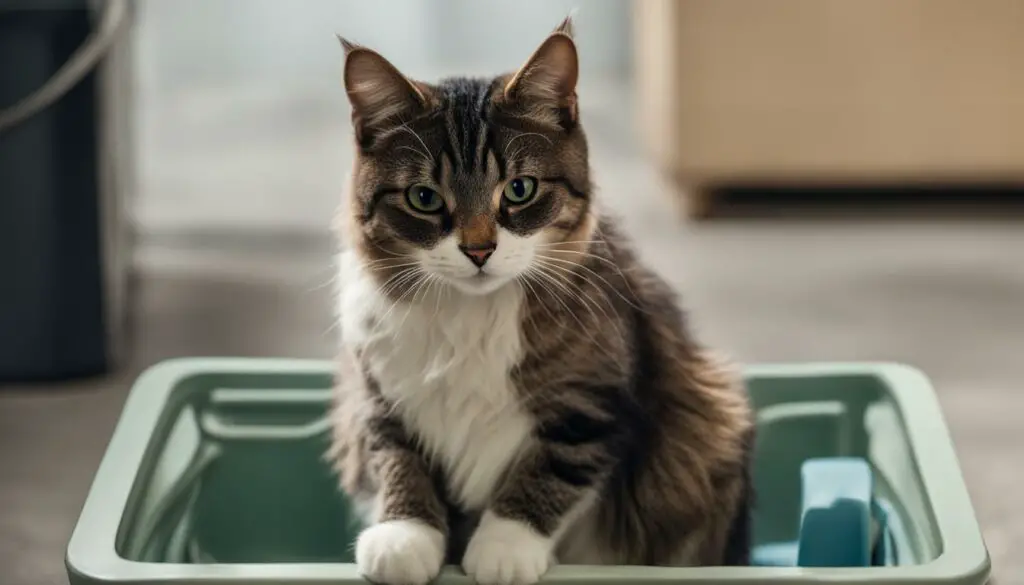As a cat owner, it’s essential to understand the common urinary issues that can affect our feline friends. One of the most prevalent is a urinary tract infection (UTI), which can cause discomfort and serious complications if left untreated. In this comprehensive guide, I will provide you with valuable information on cat UTIs, including their symptoms, causes, treatment options, and preventive measures.
Key Takeaways:
- Cat UTIs are common and can cause discomfort and complications.
- Recognizing the symptoms of cat UTI is crucial for early detection and treatment.
- Various factors can contribute to the development of cat UTI, including bacterial infections, urinary stones, and underlying health conditions.
- Diagnosing cat UTI involves a comprehensive urinalysis and may require additional diagnostic tests.
- Treatment options for cat UTI include antibiotics, clearing obstructions, special diets, and pain management.
- While there are some home remedies that may support cat UTI treatment, it is crucial to consult with a veterinarian for proper care.
- Preventing cat UTIs involves maintaining urinary tract health through specific diets and regular veterinary check-ups.
Recognizing the Symptoms of Cat UTI
When it comes to cat urinary tract infections (UTIs), it is crucial to be able to recognize the symptoms and seek prompt veterinary care. Look out for the following signs in your cat:
| Symptoms of Cat UTI |
|---|
| Frequent urination |
| Urinating outside the litter box |
| Blood in urine |
| Straining to urinate |
| Pain while urinating |
| Increased licking of the urinary opening |
If your cat exhibits any of these symptoms, it could indicate a urinary tract problem. It is important to schedule a visit to the veterinarian for a proper diagnosis. UTIs can cause discomfort and serious complications if left untreated, so early intervention is key.
By being aware of the symptoms and seeking veterinary care, you can ensure that your furry friend receives the necessary treatment to overcome a UTI and restore urinary tract health.
Common Causes of Cat UTI
When it comes to urinary tract infections (UTIs) in cats, there are several common causes to be aware of. These include bacterial infections in the bladder or urethra, urinary stones that can irritate the urinary tract, urethral obstructions that prevent proper urination, and feline idiopathic cystitis, which is bladder inflammation without infection or stones. Other underlying health conditions such as diabetes or thyroid issues can also contribute to the development of UTIs in cats.
Identifying the specific cause of a cat’s UTI is important in order to determine the most appropriate treatment approach. While bacterial infections are a frequent cause, it is crucial to rule out other potential factors. This can be done through a comprehensive examination by a veterinarian, which may include a physical evaluation, urinalysis, and potentially additional diagnostic tests. The underlying cause of the UTI will help guide the treatment plan and improve the overall well-being of the cat.
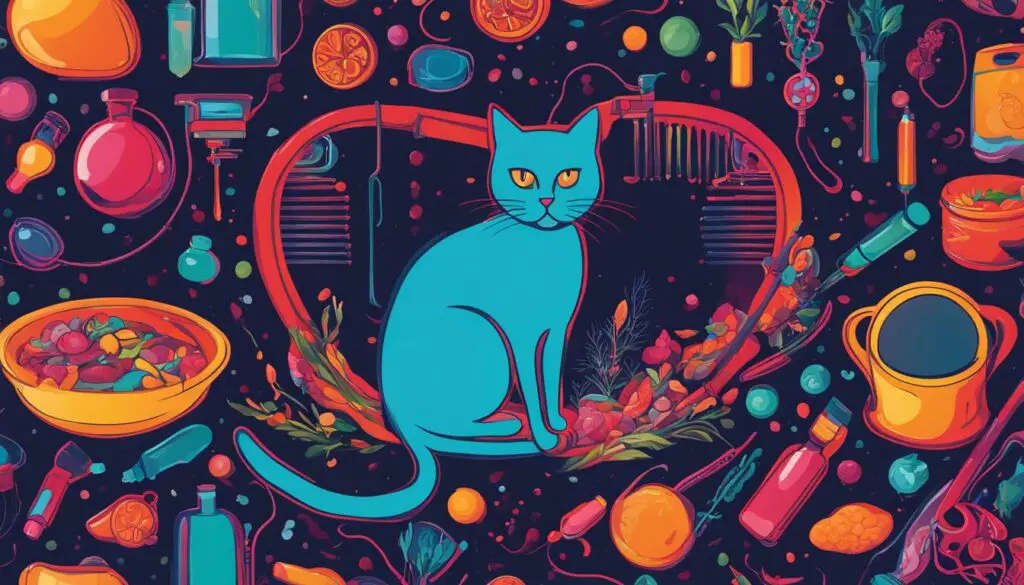
| Cause | Description |
|---|---|
| Bacterial infection | Infection in the bladder or urethra |
| Urinary stones | Stones that irritate the urinary tract |
| Urethral obstruction | Blockage preventing proper urination |
| Feline idiopathic cystitis | Bladder inflammation without infection or stones |
| Other underlying health conditions | Such as diabetes or thyroid issues |
By understanding the common causes of cat UTIs, pet owners can take proactive steps to prevent these infections and ensure the overall health and well-being of their feline companions.
Diagnosis of Cat UTI
Diagnosing a cat with a urinary tract infection (UTI) requires a thorough examination and specific tests to confirm the presence of an infection and guide treatment decisions. The most common diagnostic tool used is a urinalysis, which involves analyzing a urine sample for various parameters.
A urinalysis can provide valuable information about the cat’s urinary health, including urine specific gravity, pH levels, and the presence of indicators such as ketones, glucose, bilirubin, blood, and protein. These indicators can help determine the severity of the infection and identify any underlying issues that may contribute to the UTI.
In addition to analyzing the chemical composition of the urine, a urinalysis also evaluates the presence of debris, such as red blood cells, white blood cells, bacteria, and crystals. This evaluation helps further assess the extent of the infection and guides treatment decisions.
| Parameter | Normal Range |
|---|---|
| Specific Gravity | 1.015-1.060 |
| pH | 6-7 |
| Ketones | None |
| Glucose | None |
| Bilirubin | None |
| Blood | None |
| Protein | None or trace |
A urinalysis is a valuable tool in diagnosing cat UTIs and provides essential information for effective treatment. It is important to consult with a veterinarian for proper diagnosis and to discuss the most appropriate treatment options for your cat.
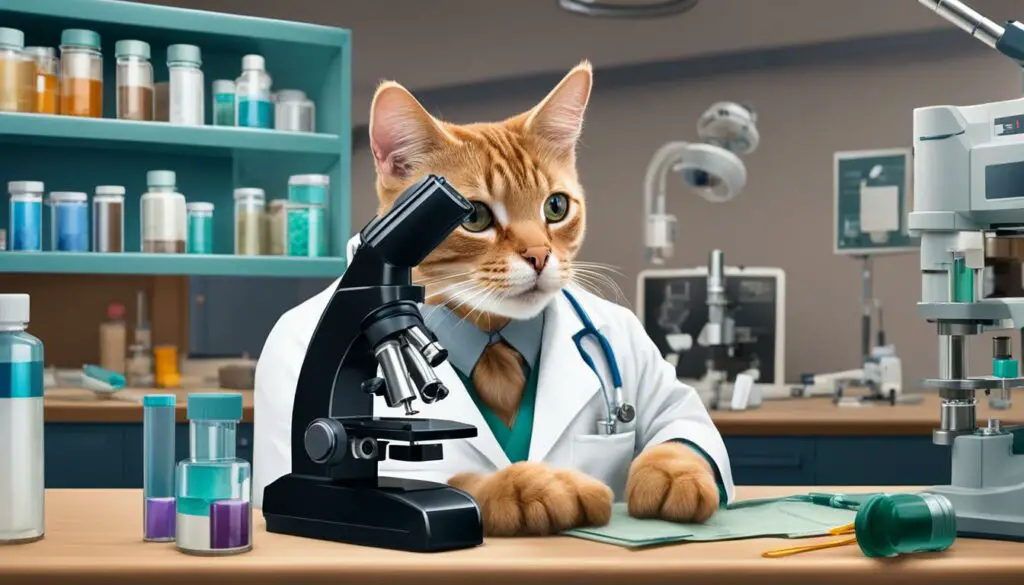
Treatment Options for Cat UTI
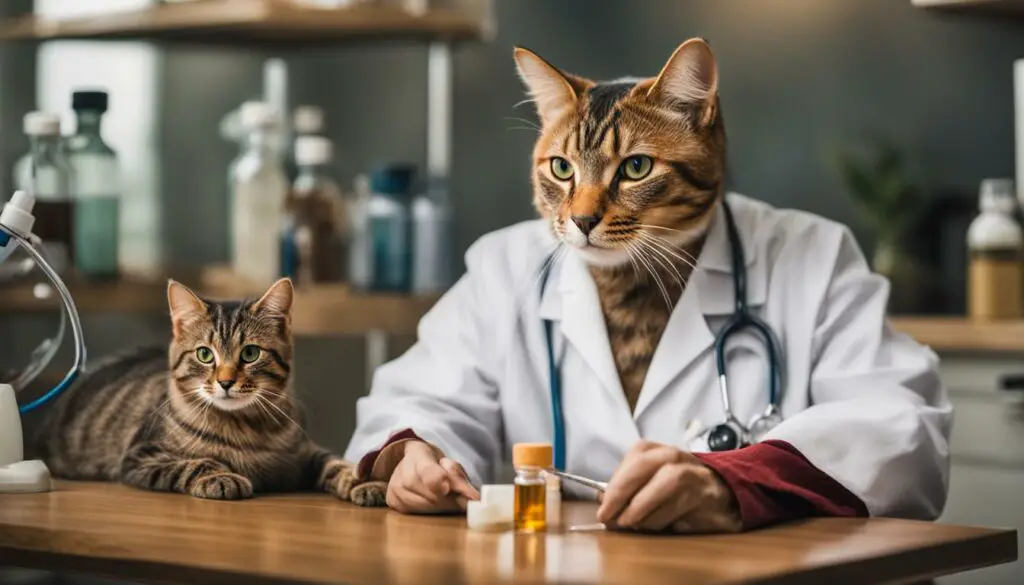
When it comes to treating cat UTIs, there are several options available to help alleviate symptoms and promote healing. The specific treatment plan will depend on the underlying cause diagnosed by a veterinarian. Here are some common treatment options:
Antibiotics
If a bacterial infection is the cause of the UTI, antibiotics may be prescribed to eliminate the infection and prevent further complications. It is important to administer the prescribed antibiotics as directed and complete the full course of treatment to ensure effective eradication of the infection.
Clearing Obstructions in the Urethra
In cases where a urethral obstruction is present, clearing the obstruction is necessary to restore normal urine flow. This may involve catheterization or surgery performed by a veterinarian. Prompt intervention is crucial to prevent severe complications associated with urinary blockage.
Special Diet
For cats with urinary stones, a special diet may be recommended to help dissolve the stones and prevent their formation. These diets are formulated to promote urinary tract health and help prevent the recurrence of UTIs.
Pain Management
To alleviate discomfort and pain associated with cat UTIs, appropriate pain management measures may be implemented. This may include the administration of pain medications or anti-inflammatory drugs to provide relief and improve the overall well-being of the cat.
It is important to consult a veterinarian for a proper diagnosis and treatment plan tailored to the individual needs of your cat. Early intervention and appropriate treatment are essential for effectively managing cat UTIs and ensuring your feline friend’s long-term urinary tract health.
Home Remedies for Cat UTI
While it is important to consult with a veterinarian for proper treatment, there are some home remedies that may help support the treatment of cat UTIs. These remedies can be used in conjunction with veterinary care to provide additional support and promote urinary tract health in cats.
Cranberries
Cranberries are often associated with urinary tract health in humans, and they may also offer benefits for cats with UTIs. Cranberries contain compounds that can lower the pH of urine, creating an environment less favorable for bacterial growth. Adding a teaspoon of cranberry juice or a small amount of cranberry powder to your cat’s food can help promote urinary health.
Apple Cider Vinegar
Apple cider vinegar is another natural remedy that may help prevent and treat cat UTIs. It can help lower the pH of urine, making it more acidic, which can inhibit the growth of bacteria. Mix a teaspoon of apple cider vinegar with your cat’s water or add it to their wet food to help support urinary health.
Glucosamine and Chondroitin
Glucosamine and chondroitin are commonly used to support joint health in cats, but they may also have benefits for the urinary tract. These supplements can help reduce inflammation and strengthen the bladder lining, potentially reducing the symptoms of a UTI. Consult with your veterinarian to determine the appropriate dosage for your cat.
Marshmallow Root
Marshmallow root is a traditional herbal remedy known for its soothing properties. It contains compounds that can kill bacteria and reduce inflammation in the urinary tract. You can find marshmallow root in supplement form or as a tea. Consult with your veterinarian for the correct dosage and administration method.
Bone Broth
Bone broth is rich in nutrients and can help keep your cat hydrated, which is important for urinary tract health. It also provides essential amino acids that support overall immune system function. Offer bone broth as a tasty and nutritious addition to your cat’s diet, or freeze it into ice cubes for a refreshing treat.
Remember, while these home remedies may offer some support for cat UTIs, they are not a replacement for veterinary care. It is essential to work closely with your veterinarian to diagnose and treat your cat’s urinary issues effectively.

Preventing Cat UTI
Keeping your cat’s urinary tract healthy is crucial to prevent urinary tract infections (UTIs) and ensure their overall well-being. By following a few preventive measures and implementing specific diets for lower urinary tract health, you can minimize the risk of your cat developing UTIs.
The Importance of Urinary Tract Health
Cats are prone to urinary issues, including UTIs, which can cause discomfort and potential complications. UTIs occur when bacteria enter the urinary tract, leading to infection and inflammation. To maintain your cat’s urinary tract health, consider the following preventive measures:
- Provide fresh water: Ensure your cat has access to clean, fresh water at all times. Adequate hydration helps flush the urinary tract and prevent the formation of urinary crystals or stones.
- Promote a balanced diet: Feed your cat a high-quality, balanced diet that supports urinary tract health. Look for cat foods specifically formulated to prevent urinary issues, which often have reduced levels of minerals that contribute to stone formation.
- Encourage regular exercise: Physical activity helps maintain a healthy weight and reduces the risk of obesity, which is a risk factor for urinary issues in cats.
- Keep the litter box clean: Regularly clean your cat’s litter box to prevent the accumulation of bacteria and irritants that can contribute to UTIs.
- Reduce stress: Minimize stressors in your cat’s environment, as stress can weaken the immune system and make them more susceptible to infections and urinary issues.
Specific Diets for Lower Urinary Tract Health
In addition to general preventive measures, specific diets can play a crucial role in preventing cat UTIs. These diets are specially formulated to support urinary tract health and reduce the risk of crystal or stone formation. They typically have controlled mineral levels, adjusted urinary pH, and added ingredients that promote urinary health:
| Diet Name | Description |
|---|---|
| Brand A Urinary Health Formula | A nutritionally balanced diet with controlled mineral levels, promoting urinary tract health and preventing the formation of stones. |
| Brand B Urinary Care Recipe | A specialized cat food with added ingredients like cranberries and glucosamine, which support urinary health and reduce the risk of UTIs. |
| Brand C Urinary Support Formula | A veterinarian-recommended diet with optimized urinary pH and reduced mineral levels to maintain a healthy urinary system. |
Consult with your veterinarian to determine the most suitable diet for your cat’s specific needs and incorporate it into their feeding routine. Regular check-ups and ongoing monitoring of their urinary health will help detect any potential issues early and ensure proactive treatment.

“Preventing UTIs in cats is all about maintaining a healthy urinary tract through proper hydration, balanced diets, regular exercise, and stress reduction. Additionally, specialized diets formulated for lower urinary tract health can significantly reduce the risk of UTIs and the formation of crystals or stones.”
Understanding FLUTD, FIC, and Urinary Issues in Cats
FLUTD, which stands for feline lower urinary tract disease, encompasses a range of urinary issues that can affect our feline companions. One common condition within this group is feline idiopathic cystitis (FIC), characterized by inflammation of the bladder without any underlying infection or stones. It’s important for cat owners to understand these terms to recognize the broad spectrum of urinary issues that cats may experience and seek appropriate veterinary care.
FLUTD and FIC can cause significant discomfort and potentially lead to serious complications if left untreated. Cats experiencing urinary issues may exhibit symptoms such as frequent urination, urinating outside the litter box, straining during urination, blood in the urine, and excessive licking of the genital area. These signs indicate a potential problem in the lower urinary tract and should prompt a visit to the veterinarian for evaluation and diagnosis.
Common Causes of FLUTD and FIC
The exact causes of FLUTD and FIC are not always clear-cut, but several factors can contribute to their development. These can include urinary tract infections, bladder inflammation, stress, bladder stones, underlying health conditions such as diabetes or kidney disease, weight and grooming issues, and anatomical defects in the urinary tract. Identifying the underlying cause is important for determining the most appropriate treatment approach and preventive measures.
Quote:
Understanding FLUTD and FIC is crucial for cat owners to recognize when their furry friends may be experiencing urinary issues. Prompt veterinary care and appropriate treatment can help alleviate discomfort and prevent serious complications.” – Dr. Emily Smith, Veterinarian
When it comes to FLUTD, FIC, and other urinary issues in cats, early intervention and proper management are essential for ensuring the well-being of our feline companions. By understanding the symptoms, causes, and available treatment options, cat owners can take proactive steps to maintain optimal urinary tract health and provide the best possible care for their beloved pets.
Signs of Urinary Issues in Cats
Cats with urinary issues may display a range of symptoms that can indicate a potential problem in the lower urinary tract. It is essential to pay attention to these signs and seek veterinary care for proper evaluation and diagnosis. Some common signs of urinary issues in cats include:
- Frequent urination: Cats with urinary issues may urinate more frequently than usual.
- Urinating outside the litter box: If your cat starts urinating outside the litter box, it could be a sign of urinary issues.
- Straining during urination: Cats experiencing discomfort while urinating may strain or show signs of pain.
- Blood in urine: The presence of blood in the urine can indicate a urinary tract problem.
- Excessive licking of the genital area: Cats with urinary issues may lick their genital area excessively to relieve discomfort.
If you notice any of these symptoms in your cat, it is crucial to consult with a veterinarian. Ignoring these signs could lead to complications and potentially life-threatening conditions such as urinary obstructions. Timely veterinary care is essential to ensure the well-being and health of your feline companion.
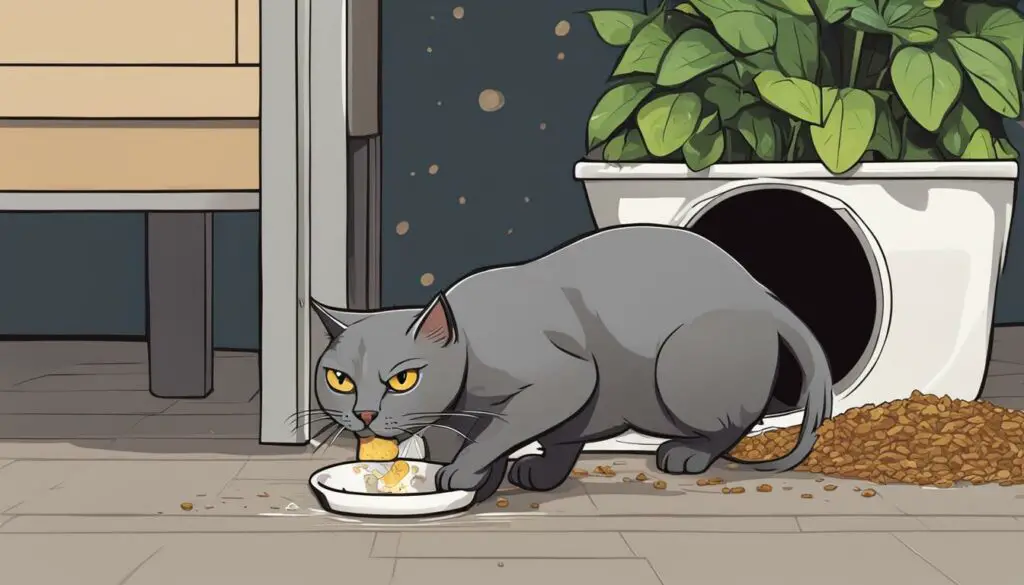
Causes of Urinary Issues in Cats
Urinary issues in cats can be caused by a variety of factors, including:
- Urinary Tract Infections: Bacterial infections in the urinary tract can lead to inflammation and discomfort.
- Bladder Inflammation: Inflammation of the bladder can result from a variety of causes, including infections, irritants, or autoimmune conditions.
- Stress: Cats can experience stress that can contribute to urinary issues, such as changes in the environment or routine.
- Bladder Stones: The formation of bladder stones can block the urinary tract and cause symptoms such as frequent urination or difficulty urinating.
- Underlying Health Conditions: Cats with underlying health conditions, such as diabetes or kidney disease, may be more prone to developing urinary issues.
- Weight and Grooming Issues: Overweight cats or those with grooming issues that lead to ingestion of excessive hair can be at higher risk for urinary problems.
- Anatomical Defects: Some cats may be born with anatomical defects in the urinary tract that make them more susceptible to urinary issues.
Identifying the underlying cause of urinary issues is essential in order to provide appropriate treatment and preventive measures. If your cat is experiencing any symptoms of urinary issues, it’s important to consult with a veterinarian for a proper diagnosis and treatment plan.
| Cause | Description |
|---|---|
| Urinary Tract Infections | Bacterial infections in the urinary tract can lead to inflammation and discomfort. |
| Bladder Inflammation | Inflammation of the bladder can result from a variety of causes, including infections, irritants, or autoimmune conditions. |
| Stress | Cats can experience stress that can contribute to urinary issues, such as changes in the environment or routine. |
| Bladder Stones | The formation of bladder stones can block the urinary tract and cause symptoms such as frequent urination or difficulty urinating. |
| Underlying Health Conditions | Cats with underlying health conditions, such as diabetes or kidney disease, may be more prone to developing urinary issues. |
| Weight and Grooming Issues | Overweight cats or those with grooming issues that lead to ingestion of excessive hair can be at higher risk for urinary problems. |
| Anatomical Defects | Some cats may be born with anatomical defects in the urinary tract that make them more susceptible to urinary issues. |
Identifying the underlying cause of urinary issues is essential in order to provide appropriate treatment and preventive measures. If your cat is experiencing any symptoms of urinary issues, it’s important to consult with a veterinarian for a proper diagnosis and treatment plan.
Understanding the Importance of Prompt Veterinary Care
When it comes to urinary issues in cats, prompt veterinary care is of utmost importance. Untreated urinary issues can lead to feline urinary obstruction, which is a life-threatening condition that requires immediate treatment. Failure to address urinary problems can result in complications such as potential kidney damage and the development of urinary stones. Therefore, recognizing the urgency of the situation and seeking timely veterinary care is essential for the well-being of cats with urinary issues.
Feline urinary obstruction occurs when there is a blockage in the urinary tract, preventing the cat from urinating normally. This is a serious condition that can quickly become life-threatening if not addressed promptly. Cats with urinary obstruction may experience symptoms such as repeated attempts to urinate without producing urine, vocalization or crying in pain, a distended abdomen, and signs of distress. If you notice any of these signs, it is crucial to seek immediate veterinary care to prevent fatal complications.
Untreated urinary issues can also lead to potential kidney damage. When the urinary tract is blocked or inflamed, urine may back up into the kidneys, causing kidney dysfunction or even renal failure. Additionally, the presence of urinary stones can cause further damage to the kidneys if left untreated. To avoid these serious complications, it is essential to address urinary issues promptly and seek appropriate veterinary care.
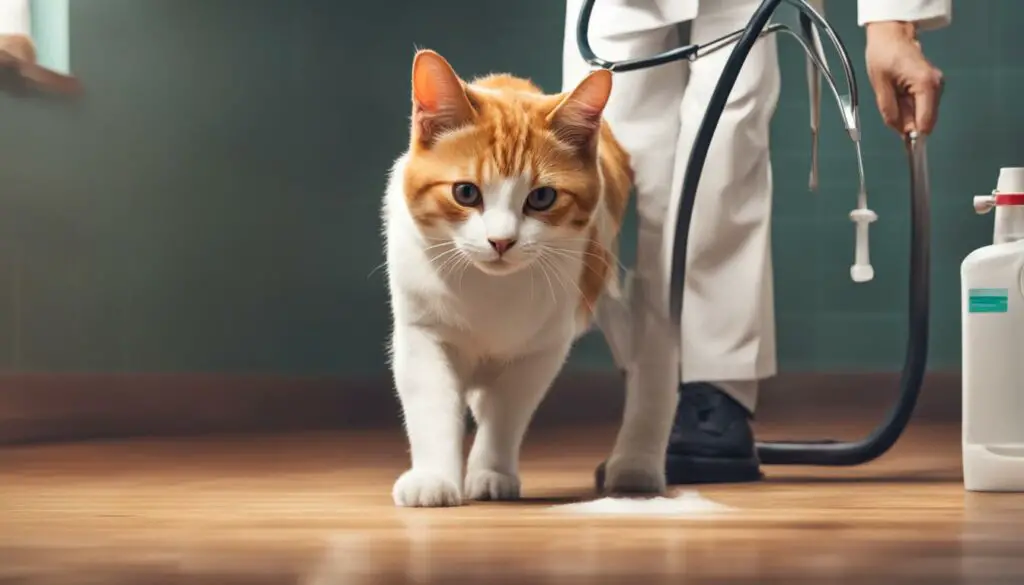
In conclusion, understanding the importance of prompt veterinary care for urinary issues in cats is crucial for their well-being. Complications of untreated urinary issues can be severe, including feline urinary obstruction, potential kidney damage, and the development of urinary stones. Seeking immediate treatment for urinary obstruction is essential to prevent fatal consequences. By recognizing the urgency and promptly seeking veterinary care, we can ensure that cats with urinary issues receive the care they need to recover and maintain optimal urinary tract health.
Diagnosis of Urinary Issues in Cats
Diagnosing urinary issues in cats involves performing various diagnostic tests to determine the underlying cause and guide treatment decisions. The first step is a urinalysis, which assesses different parameters of the urine, including specific gravity, pH levels, and the presence of bacteria, blood, and crystals. This helps identify the presence of a urinary tract infection or other abnormalities. If a bacterial infection is suspected, a urine culture and sensitivity test may be conducted to identify the specific bacteria causing the infection and select the most effective antibiotic treatment.
Additional diagnostic tests, such as bloodwork, X-rays, or ultrasounds, may be recommended to further evaluate the overall health of the urinary tract and identify any underlying conditions or complications. Bloodwork can provide valuable information about the cat’s kidney function and overall health. X-rays and ultrasounds can help visualize the urinary tract and detect any obstructions, abnormalities, or urinary stones that may require specific treatments or interventions.
Examples of Diagnostic Tests for Urinary Issues in Cats:
- Urinalysis: Measures specific gravity, pH levels, and detects the presence of bacteria, blood, and crystals.
- Urine Culture and Sensitivity: Identifies the specific bacteria causing a urinary tract infection and determines the most effective antibiotics for treatment.
- Bloodwork: Evaluates kidney function and overall health.
- X-rays: Visualizes the urinary tract to detect obstructions, abnormalities, or urinary stones.
- Ultrasound: Provides detailed images of the urinary tract to assess its health and detect any issues or abnormalities.
By conducting these diagnostic tests, veterinarians can accurately diagnose urinary issues in cats and develop a tailored treatment plan to address the underlying cause and promote the cat’s urinary health.
| Diagnostic Tests | Purpose |
|---|---|
| Urinalysis | To assess parameters of the urine and detect urinary tract infections or abnormalities. |
| Urine Culture and Sensitivity | To identify the specific bacteria causing an infection and determine the most effective antibiotics for treatment. |
| Bloodwork | To evaluate kidney function and overall health. |
| X-rays | To visualize the urinary tract and detect obstructions, abnormalities, or urinary stones. |
| Ultrasound | To provide detailed images of the urinary tract and assess its health. |
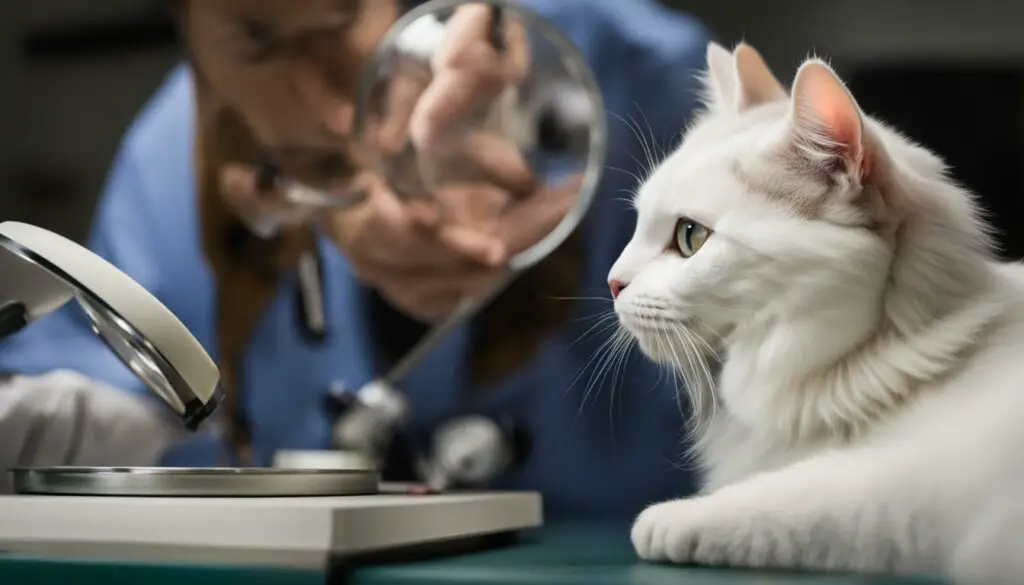
Treatment Options for Urinary Issues in Cats
When it comes to treating urinary issues in cats, there are several options available to alleviate symptoms and promote overall urinary tract health. The specific treatment plan will depend on the underlying cause diagnosed by a veterinarian. Here are some common treatment options for urinary issues in cats:
- Antibiotics: If a urinary tract infection is present, antibiotics may be prescribed to eliminate the bacterial infection and reduce inflammation.
- Pain medications and anti-inflammatories: These medications can help alleviate discomfort and reduce inflammation in the urinary tract.
- Adequate water intake: Ensuring that your cat drinks enough water can help flush the urinary tract and prevent the formation of urinary stones.
- Treatment of underlying causes: If urinary issues are caused by underlying health conditions such as diabetes or kidney disease, treating these conditions may help improve urinary health.
It’s important to follow the veterinarian’s instructions and complete the full course of any prescribed medications. Regular check-ups and reevaluation of the cat’s condition may be necessary to monitor progress and adjust the treatment plan if needed.
Remember, it’s always best to consult with a veterinarian for proper diagnosis and treatment guidance. They will be able to recommend the most appropriate treatment options based on the specific needs of your cat.

An Overview of Urinary Obstructions in Cats
A urinary obstruction in cats is a life-threatening condition that requires immediate veterinary treatment. It occurs when there is a blockage in the urinary tract, preventing the cat from urinating normally. This obstruction can lead to a buildup of toxic waste products in the body, causing severe illness and potentially fatal complications.
The symptoms of a urinary obstruction in cats are often easy to recognize. Affected cats may repeatedly attempt to urinate without producing any urine, vocalize or cry in pain, have a distended abdomen, and show signs of distress. It is essential to seek immediate veterinary care if you observe any of these symptoms, as a urinary obstruction is a medical emergency.
Veterinary treatment for a urinary obstruction typically involves relieving the blockage by catheterizing the urethra or performing surgery if necessary. The cat may also require intravenous fluids to correct dehydration and imbalances in the body. Once the obstruction is resolved, the veterinarian will closely monitor the cat’s urinary function and overall health to ensure a full recovery.
“A urinary obstruction in cats is a serious condition that requires prompt veterinary attention. Delaying treatment can lead to life-threatening complications. If you notice any symptoms of a urinary obstruction in your cat, such as difficulty or inability to urinate, seek immediate veterinary care.”
Prevention of urinary obstructions in cats can be challenging as some cases have no identifiable cause. However, there are steps you can take to help reduce the risk. Encouraging your cat to drink plenty of water and providing a balanced diet formulated for urinary tract health may help prevent the formation of urinary crystals or stones. Regular veterinary check-ups are also crucial for early detection and management of any underlying conditions that could contribute to urinary obstructions.
| Symptoms of Urinary Obstruction in Cats | Immediate Veterinary Treatment |
|---|---|
|
|
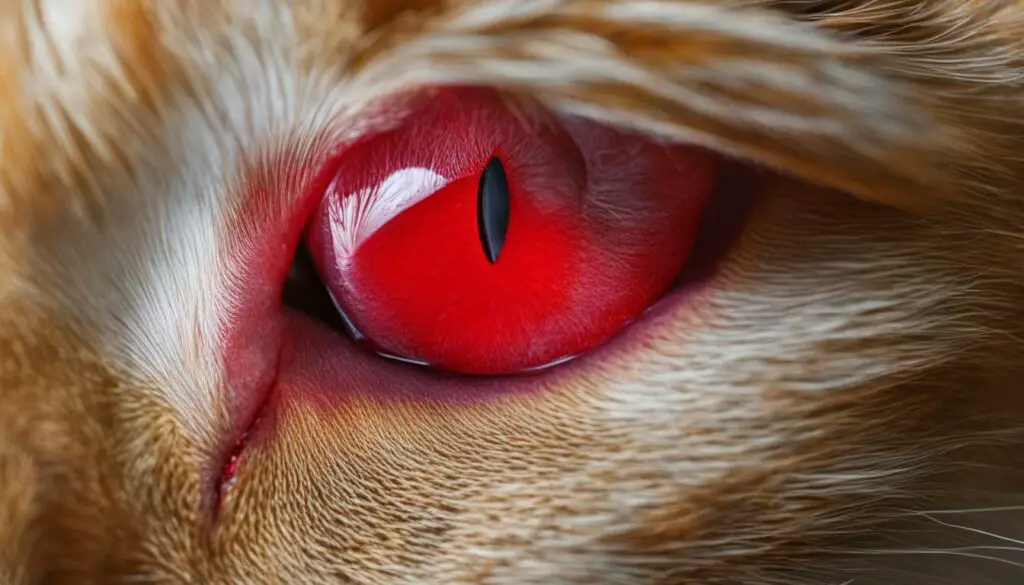
Importance of Rechecking and Follow-up Care
After undergoing treatment for a cat urinary tract infection (UTI), it is crucial to recheck the urine to confirm the resolution of the infection and monitor the cat’s urinary health. This follow-up care is essential to prevent the recurrence of UTIs and address any persistent issues that may arise. By rechecking the urine, veterinarians can ensure that the infection has been effectively treated and that the cat’s urinary tract is functioning properly.
Rechecking the urine allows veterinarians to assess key indicators such as the presence of bacteria, blood, or crystals. This information provides valuable insights into the cat’s urinary health and helps determine if further treatment is necessary. Additionally, rechecking the urine helps identify any underlying causes that may have contributed to the UTI, such as bladder stones or underlying health conditions. Addressing these underlying factors is crucial in preventing future UTIs and maintaining the cat’s overall well-being.
In addition to rechecking the urine, follow-up care may involve ongoing monitoring of the cat’s urinary health. This can include regular check-ups with the veterinarian, periodic urine testing, and maintaining good hydration through adequate water intake. By closely monitoring the cat’s urinary health, any potential issues can be identified and addressed promptly, preventing further complications.
Overall, rechecking the urine and providing follow-up care are essential steps in the management of cat UTIs. By confirming the resolution of the infection, monitoring urinary health, preventing recurrence, and addressing any persistent issues, cat owners can ensure their feline companions maintain optimal urinary tract health. Consulting with a veterinarian and following their recommended follow-up care plan is crucial for the long-term well-being of cats with UTIs.
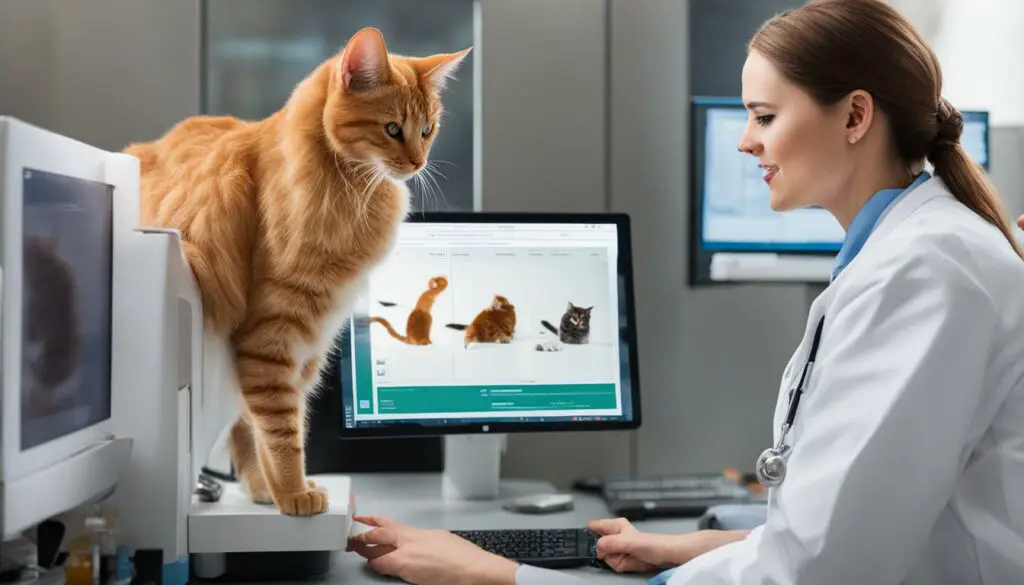
| Benefits of Rechecking and Follow-up Care |
|---|
| Confirms resolution of infection |
| Monitors urinary health |
| Prevents recurrence of UTIs |
| Addresses persistent urinary issues |
“`
Conclusion
In conclusion, maintaining urinary tract health is crucial for the overall well-being of our feline friends. Cat urinary tract infections (UTIs) and other urinary issues can cause discomfort and lead to serious complications if left untreated. Therefore, it is important to prioritize veterinary care and take preventive measures to ensure optimal urinary tract health in cats.
Regular check-ups with a veterinarian and monitoring for any underlying health conditions are essential preventive measures. By addressing any potential issues early on, we can provide the necessary treatment and avoid further complications. Additionally, providing a diet that supports lower urinary tract health, such as those formulated for urinary health, can help prevent the formation of urinary stones and reduce the risk of UTIs.
When it comes to cat UTIs and urinary issues, timely intervention is crucial. Seeking prompt veterinary care at the first signs of symptoms is vital to prevent complications and ensure a speedy recovery. With the right treatment approach, including antibiotics, pain management, and addressing underlying causes, we can restore our cats’ urinary health and improve their quality of life.
Remember, prevention is always better than cure. By prioritizing urinary tract health and taking preventive measures, such as regular check-ups, proper nutrition, and providing plenty of fresh water, we can help minimize the risk of urinary issues in our beloved feline companions. Let’s stay proactive in maintaining their urinary tract health and ensuring they live happy and healthy lives.
FAQ
What are the symptoms of cat UTI?
The symptoms of cat UTI include frequent urination, urinating outside the litter box, blood in urine, straining to urinate, pain while urinating, and increased licking of the urinary opening.
What are the common causes of cat UTI?
Cat UTI can be caused by bacterial infections in the bladder or urethra, urinary stones, urethral obstructions, feline idiopathic cystitis, and other underlying health conditions.
How is cat UTI diagnosed?
Cat UTI is diagnosed through a urinalysis, which measures various parameters of the urine and evaluates the presence of bacteria, blood, and crystals.
What are the treatment options for cat UTI?
Treatment options for cat UTI may include antibiotics, clearing obstructions in the urethra, recommending a special diet, and providing pain management.
Are there any home remedies for cat UTI?
Yes, some home remedies that may support the treatment of cat UTI include cranberries, apple cider vinegar, glucosamine and chondroitin, marshmallow root, and bone broth.
How can I prevent cat UTI?
Preventing cat UTI involves maintaining urinary tract health through proper diet and regular veterinary check-ups.
What is FLUTD and FIC?
FLUTD stands for feline lower urinary tract disease, and FIC is feline idiopathic cystitis. They are terms used to describe various urinary issues in cats.
What are the signs of urinary issues in cats?
The signs of urinary issues in cats include frequent urination, urinating outside the litter box, straining during urination, blood in urine, and excessive licking of the genital area.
What are the causes of urinary issues in cats?
Urinary issues in cats can be caused by urinary tract infections, bladder inflammation, stress, bladder stones, underlying health conditions, weight and grooming issues, and anatomical defects.
Why is prompt veterinary care important for urinary issues in cats?
Prompt veterinary care is important to prevent complications such as feline urinary obstruction, kidney damage, and the development of urinary stones.
How are urinary issues in cats diagnosed?
Urinary issues in cats are diagnosed through urinalysis, urine culture, and sensitivity tests, as well as additional diagnostic tests like bloodwork, X-rays, or ultrasound.
What are the treatment options for urinary issues in cats?
Treatment options for urinary issues in cats may include antibiotics, pain medications, anti-inflammatories, promoting water intake, and addressing underlying health conditions.
What are urinary obstructions in cats?
Urinary obstructions in cats are life-threatening conditions that require immediate veterinary treatment. Symptoms include repeated attempts to urinate without producing urine, vocalization in pain, a distended abdomen, and signs of distress.
How important is rechecking and follow-up care for urinary issues in cats?
Rechecking the urine after treatment and follow-up care are important to confirm the resolution of the infection, monitor urinary health, and prevent recurring issues.
Source Links
- https://bondvet.com/b/uti-in-cats-symptoms-diagnosis-treatment-and-prevention
- https://www.webmd.com/pets/cats/cat-urinary-tract-problems
- https://vcahospitals.com/know-your-pet/urinary-tract-infections-utis-in-cats

